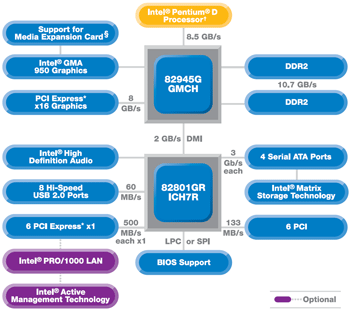Pentium D 820 and i945G/P Chipset Showcase
i945G/P Express Chipset and GMA 950 Performance
|
AMT -
The 945 series chipsets brings a fair amount of scalability to the everyday consumer and business-class environment. Along with support for virtually all Pentium processors except for the dual-core Pentium EE, the 945 series delivers a major new tool to the professional with Intel Active Management Technology (AMT). 945G/P chipset motherboards equipped with AMT will enable IT professionals to manage a plethora of workstation functions remotely, improving troubleshooting response time, management of system resources, and even recovery of the operating system by restoring from remote images. There is even the ability to manage the installation of the OS remotely. Additionally, with the help of third-party software, AMT will enable IT managers to simplify asset management, allowing for remote inventory of a system's hardware and software. By enabling support personnel to handle these tasks from a single location, the effective response time to problems will reduce overall downtime when issues arise.
IVT -
The 945 is also built to grow with future processor enhancements such as Intel's Virtualization Technology. With an IVT-enabled processor, IT will be able to run multiple OSes on several secure partitions simultaneously. In fact, the options that will be available can greatly improve productivity across the board. While this new feature has yet to reach market, Intel has built support for Intel's Virtualization Technology into the 945 series chipset, so they're targeting readiness when IVT goes prime-time. To get more information on Intel's Virtualization Technology, read up on it at www.intel.com.
| Intel 945P Chipset |

| Intel 945G Chipset |

Intel has also outfitted the i945G chipset with its new Graphics Media Accelerator 950 graphics core. The GMA 950 brings improved DirectX9 support as well as support for native high-definition displays. The GMA 950 also supports separate Media Expansion Cards and ADD2, which adds Dual Display, DVI, HDTV, and Composite and Component out with a single add-on card. These are all features that previously required a full graphics card upgrade. While integrated graphics is known for using precious CPU cycles, when coupled with a dual-core CPU, the GMA 950 promises better overall performance than its predecessors.
To briefly demonstrate the performance differences with the GMA 950, we ran a quick series of gaming tests, comparing it to a 915G chipset-based board with GMA 900 integrated graphics.

To keep the comparison accurate, we compared the two running a single-core Pentium 4 530J because the 915 doesn't support dual-core CPUs. For good measure, we started off the test with the Pentium D 820 to show performance with a dual-core processor.
Overall, the GMA 950 managed to add a few frames over the GMA 900 in Halo, while the GMA 900 managed a better Half-Life 2 score. When equipped with a dual-core processor, the GMA 950 showed little difference with Halo, while tacking a little over 4 FPS with Half-Life 2. As these quick tests show, the GMA 950 does add slightly better performance over previous Intel graphics solutions, but in the end, gaming is best ventured into with a dedicated add-on 3D graphics card. Having said that, we're certain the 2D core of the GMA950 is up to the task on the desktop.






